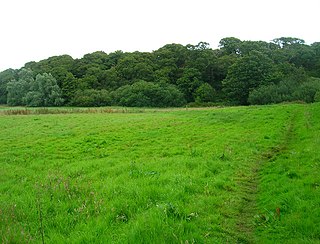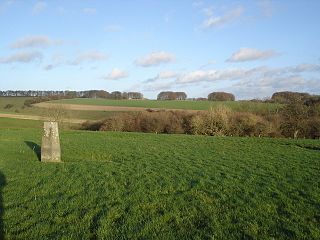
Belle Vue Quarry (grid reference SZ014782 ) is a 3.2 hectare biological Site of Special Scientific Interest in Dorset, notified in 1977.
It is used as a roosting site by Greater Horseshoe bats.

Belle Vue Quarry (grid reference SZ014782 ) is a 3.2 hectare biological Site of Special Scientific Interest in Dorset, notified in 1977.
It is used as a roosting site by Greater Horseshoe bats.
Coordinates: 50°36′13″N1°58′54″W / 50.60352°N 1.98158°W
Lacey's Farm Quarry is a 1,300 square metre geological Site of Special Scientific Interest near the town of Freshwater, Isle of Wight, notified in 1993.
Alverstone Marshes is an 83.8 hectare biological Site of Special Scientific Interest on the Isle of Wight, notified in 1951.

America Wood is a 21.4 hectare biological Site of Special Scientific Interest on the Isle of Wight, notified in 1986. Legend has it that the name derives from the use of oak trees grown here to build ships utilised in the American War of Independence. However, the name Americas Wood appears on Andrews Map of the Island in 1769, six years before the outbreak of the War of Independence.

Winkelbury Hill is a 62.95 hectare biological Site of Special Scientific Interest in Wiltshire, notified in 1971.

Aunt Mary's Bottom is an 8.62 hectare biological Site of Special Scientific Interest in Dorset, England notified in 1991.

Cull-Peppers Dish is a 0.9-hectare (2.2-acre) geological Site of Special Scientific Interest in Dorset, notified in 1989.

Rotherley Downs is a 120.05 hectare biological Site of Special Scientific Interest in Wiltshire, England, notified in 1989.

Roundway Down and Covert is an 86 hectare biological Site of Special Scientific Interest near Devizes in Wiltshire, England. It was notified in 1971.

Batcombe Down is an 18.6 hectare biological Site of Special Scientific Interest in Dorset, England: notified in 1952.
Bryanston SSSI is a 0.3 hectare biological Site of Special Scientific Interest in Dorset, England notified in 1977.

Chalbury Hill And Quarry is an 11.9 hectare biological and geological Site of Special Scientific Interest in Dorset, England, notified in 1977. The site consists of grassland and a disused limestone quarry. The SSSI includes the area covered by Chalbury Hill Fort.

Brenscombe Heath is a 34.7 hectare biological Site of Special Scientific Interest in Corfe Castle, Dorset, notified in 1985.

Bradford Abbas Railway Cutting is a 1.4 hectare geological Site of Special Scientific Interest in Dorset, notified in 1990.
Corton Cutting is a 0.24 hectare geological Site of Special Scientific Interest in Dorset, England, notified in 1997.
Goathill Quarry is a 0.3 hectare geological Site of Special Scientific Interest near Goathill in Dorset, England, notified in 1977.
Holnest SSSI, Dorset is a 54.83 hectare biological Site of Special Scientific Interest in Dorset, notified in 2004.
Oakers Bog is a 30.7 hectare biological and geological Site of Special Scientific Interest in Dorset, notified in 1988.

Black Hill Down is a 71.84 hectare biological Site of Special Scientific Interest in Dorset, notified in 1989.
Black Hill Heath is a 69.67 hectare biological Site of Special Scientific Interest in Dorset, notified in 1989.
Old Burghclere Lime Quarry SSSI is a 4.61 ha biological Site of Special Scientific Interest at Burghclere in Hampshire, notified in 1979. The Lime Quarry was actively worked until the beginning of the 20th century, and since then has been left to nature, resulting in a unique mix of flora and fauna becoming established at the site.